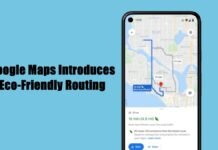
Key Points:
- Google Maps introduces “Live Lane Guidance” AI-powered real-time lane detection and guidance for connected cars
- Feature uses car’s front-facing camera and AI to analyze lane markings, road signs, and vehicle position
- Initial launch on Polestar 4 in US and Sweden; expansion to more automakers planned
- Android Automotive-exclusive feature; not available on smartphone apps (iOS/Android)
- Over 2 billion monthly users of Google Maps; feature designed to reduce missed exits and lane-change stress
New Delhi: Live Lane Guidance represents a significant technological leap beyond conventional navigation assistance, leveraging the Polestar 4’s 10.2-inch driver display and forward-facing camera infrastructure. The system’s operational foundation relies on real-time video analysis from the vehicle’s front-mounted camera, capturing lane markings, road signage, and traffic patterns. Google’s onboard artificial intelligence processes this visual data instantaneously, extracting critical spatial information about the vehicle’s exact position within road lanes.
This processed visual information integrates seamlessly with Google Maps’ powerful navigation engine, trusted by over 2 billion monthly users, creating a comprehensive situational awareness system. Unlike smartphone-based navigation that merely displays symbolic lane representations, Live Lane Guidance generates dynamic, context-aware guidance responsive to the driver’s actual real-time position. The AI continuously updates its understanding of lane positioning, enabling proactive alerts when drivers deviate from optimal lane trajectories.
Real-Time Lane Guidance: From Visual Recognition to Driver Action
The system’s practical functionality demonstrates sophisticated technical execution. When a driver approaches an upcoming exit or turn, the AI detects whether they occupy the correct lane for that maneuver. If the driver remains in the left lane while their destination exit appears on the right side of the highway, Live Lane Guidance automatically issues both visual and audio alerts indicating the required rightward lane change and the optimal timing for safe execution.
This proactive guidance system addresses a critical pain point in highway driving, the stress and danger associated with last-minute lane changes when drivers suddenly realize they occupy incorrect lanes for upcoming exits. By providing a warning with specific lane change recommendations, the system enables safer, more deliberate lane transitions. The combination of audio alerts (ensuring driver awareness regardless of visual attention allocation) and visual cues (providing specific directional guidance) creates redundant communication channels that enhance driver comprehension and response.
Polestar 4: First Vehicle Integration and Launch Timeline
The Polestar 4, Volvo’s luxury electric vehicle brand’s flagship model, becomes the inaugural vehicle to receive Live Lane Guidance integration. The feature rollout begins in the United States and Sweden over the coming months following the November 2025 announcement, with deployment occurring through Google Maps updates distributed to compatible vehicle systems. Polestar’s selection as the launch partner reflects the automaker’s commitment to technology leadership and integration of cutting-edge digital experiences within vehicle infotainment systems.
Google’s official announcement emphasized that Polestar represents merely the beginning of a broader automotive technology rollout strategy. The company indicated intentions to expand Live Lane Guidance to “more road types” and additional automobile manufacturers throughout 2025-2026. This phased expansion approach suggests Google is validating the technology across varied road conditions, traffic scenarios, and driving environments before widespread industry deployment.
Smartphone Incompatibility: Hardware Requirements and Technical Constraints
A critical limitation of Live Lane Guidance is its exclusive availability on vehicles with Google’s built-in systems, meaning complete unavailability on smartphones running iOS or Android applications. This hardware dependency reflects the technical architecture underlying Live Lane Guidance, which requires real-time integration with vehicle cameras, sensors, and computing systems that smartphones inherently lack. The feature depends on local, in-vehicle AI processing rather than cloud-based computation, ensuring minimal latency and instantaneous responsiveness critical for driving safety applications.
Consequently, Google Maps smartphone applications will retain only traditional lane guidance functionality, displaying symbolic lane representations without real-time AI-driven lane detection and proactive guidance. This divergence means millions of smartphone-dependent navigation users cannot access the advanced feature, potentially creating expectation mismatches. However, as autonomous vehicle integration becomes increasingly prevalent in newer automobile models, smartphone users upgrading to connected vehicles will gain access to Live Lane Guidance capabilities.
Safety-Centric Design Philosophy: Reducing Driving Stress and Accidents
Google explicitly frames Live Lane Guidance as a safety enhancement, emphasizing the feature’s capacity to reduce driver stress, minimize missed exits, and prevent dangerous last-minute lane changes on congested highways. The system addresses documented hazards associated with incorrect lane positioning scenarios where distracted or unfamiliar drivers suddenly realize they occupy the wrong lanes and execute emergency maneuvers, risking collisions with adjacent vehicles.
The feature particularly benefits drivers navigating unfamiliar cities or complex multi-lane highway systems where rapid, accurate lane decisions are critical. By transferring lane-selection cognitive burden from drivers to AI systems, Live Lane Guidance potentially reduces mental load, allowing drivers to maintain focus on other safety-critical tasks like forward collision avoidance and speed management. This cognitive assistance represents an important step toward human-machine partnership in vehicular operation, with technology handling navigation precision while humans retain overall driving control.
Broader Automotive Ecosystem: Google’s Android Automotive Expansion
Live Lane Guidance exemplifies Google’s strategic expansion into automotive technology through Android Automotive, an operating system designed specifically for in-vehicle infotainment systems. Over 50 automobile brands have already integrated Google’s Android Automotive platform, with announcements indicating continued expansion throughout 2025. This proliferation transforms vehicles into essentially “smartphones on wheels,” creating opportunities for sophisticated AI-driven features integrating camera systems, sensors, and computational resources.
Google’s automotive strategy positions the search giant as a fundamental technology infrastructure provider within the automotive industry, similar to how Android dominates smartphone markets. By embedding Google Maps, Google Assistant, and emerging AI features like Live Lane Guidance directly into vehicle operating systems, Google establishes deep integration that influences driver experiences and creates ecosystem lock-in effects, benefiting the technology company.
Future Expansion: Regional and Vehicular Scaling Plans
Google’s roadmap includes systematic expansion of Live Lane Guidance across geographic regions and automobile manufacturers. While initial deployment focuses on Polestar 4 in the United States and Sweden, the company plans a phased rollout to additional markets, including eventually India, according to technology analysts. The expansion will likely prioritize developed nations first due to advanced road infrastructure, standardized lane markings, and higher luxury vehicle market penetration.
Parallel to geographic expansion, Google intends to partner with additional automakers beyond Polestar, eventually making Live Lane Guidance standard technology across multiple vehicle brands and segments. This democratization of advanced navigation assistance could transform highway driving experiences globally, though complete adoption remains years away, given vehicle replacement cycles and manufacturing timelines.






















































